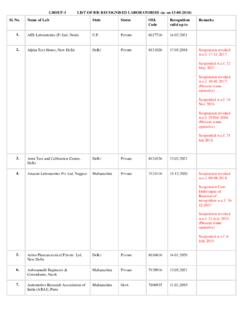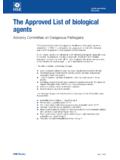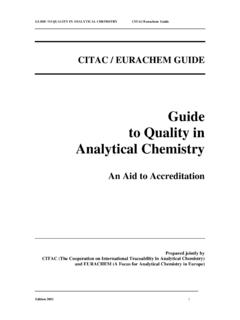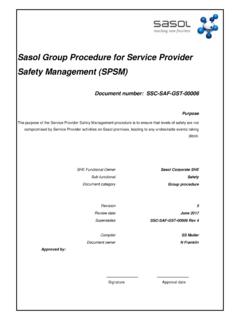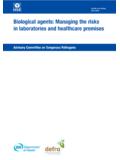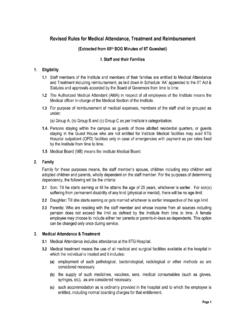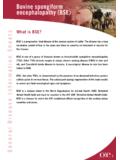Transcription of Standing Committee of Analysts
1 Standing Committee of Analysts Estimation of Uncertainty of Measurement for Chemical and Physico-chemical Determinands in Drinking Water 2018 Methods for the Examination of Waters and Associated Materials January 2018 2 Estimation of Uncertainty of Measurement for Chemical and Physico-chemical Determinands in Drinking Water Methods for the Examination of Waters and Associated Materials This booklet contains guidance on calculating uncertainty of measurement for chemical and physico-chemical determinands that are analysed for drinking water regulatory compliance 3 Contents About this series 5 Warning to users 5 A Estimation of Uncertainty of Measurement for Chemical and Physico-chemical Determinands in Drinking Water 6 A1 Foreword 6 A2 Introduction 6 A3 Scope 7 A4 Principle 7 A5 Overview of the procedure 8 A6 Preparative stage for the estimation of measurement uncertainty 9 Specification of the measurement 9 Specification of the form in which the
2 Measurement uncertainty is reported 9 A7 Evaluation of available precision and bias data 9 Approach and criteria 9 Within-laboratory reproducibility (uRw) 10 Method and laboratory bias (ub) 11 A8 Calculation of the combined standard uncertainty 12 A9 Calculation of the expanded uncertainty 12 A10 Calculation of Limit of Quantification (LoQ) 13 A11 Records 13 A12 Spreadsheets 13 UoM-BB calculations 14 UoM-BB determinands 15 Appendix 1 References 16 Appendix 2 Bibliography 17 Appendix 3 Symbols 18 Appendix 4 Definitions and Abbreviations 21 Address for correspondence 24 Members assisting with these methods 24 4 About this series Introduction This booklet is part of a series intended to provide authoritative guidance on recommended methods of sampling and analysis for determining the quality of
3 Drinking water, ground water, river water and sea water, waste water and effluents as well as sewage sludges, sediments, soils (including contaminated land) and biota. In addition, short reviews of the most important analytical techniques of interest to the water and sewage industries are included. Performance of methods Ideally, all methods should be fully evaluated with results from performance tests. These methods should be capable of establishing, within specified or pre-determined and acceptable limits of deviation and detection, whether or not any sample contains concentrations of parameters above those of interest.
4 For a method to be considered fully evaluated, individual results from at least three laboratories should be reported. The specifications of performance generally relate to maximum tolerable values for total error (random and systematic errors) systematic error (bias) total standard deviation and limit of detection. Often, full evaluation is not possible and only limited performance data may be available. In addition, good laboratory practice and analytical quality control are essential if satisfactory results are to be achieved.
5 Standing Committee of Analysts The preparation of booklets within the series Methods for the Examination of Waters and Associated Materials and their continuing revision is the responsibility of the Standing Committee of Analysts (established 1972 by the Department of the Environment). At present, there are seven working groups, each responsible for one section or aspect of water quality analysis. They are 1 General principles of sampling and accuracy of results 2 Microbiological methods 3 Empirical, Inorganic and physical methods, Metals and metalloids 4 Solid substances 5 Organic impurities 6 Biological, biodegradability and inhibition methods 7 Radiochemical methods The actual methods and reviews are produced by smaller panels of experts in the appropriate field, in co-operation with the working group and main Committee .
6 The names of those members principally associated with these methods are listed at the back of this booklet. Publication of new or revised methods will be notified to the technical press. If users wish to receive copies or advanced notice of forthcoming publications or obtain details of the index of methods then contact the Secretary on the SCA s web-page:- Every effort is made to avoid errors appearing in the published text. If, however, any are found, please notify the Secretary. Users should ensure they are aware of the most recent version they seek.
7 Rob Carter Secretary April 2017 _____ Warning to users The analytical procedures described in this booklet should only be carried out under the proper supervision of competent, trained Analysts in properly equipped laboratories. All possible safety precautions should be followed and appropriate regulatory requirements complied with. This should include compliance with the Health and Safety at Work etc Act 1974 and all regulations made under the Act, and the Control of Substances Hazardous to Health Regulations 2002 (SI 2002/2677).
8 Where particular or exceptional hazards exist in carrying out the procedures described in this booklet, then specific attention is noted. Numerous publications are available giving practical details on first aid and laboratory safety. These should be consulted and be readily accessible to all Analysts . Amongst such resources are; HSE website HSE: Information about health and safety at work ; RSC website Safe Practices in Chemical Laboratories and Hazards in the Chemical Laboratory , 1992, produced by the Royal Society of Chemistry; Guidelines for Microbiological Safety , 1986, Portland Press, Colchester, produced by Member Societies of the Microbiological Consultative Committee ; and Safety Precautions, Notes for Guidance produced by the Public Health Laboratory Service.
9 Another useful publication is Good Laboratory Practice produced by the Department of Health. 5 A Estimation of Uncertainty of Measurement for Chemical and Physico-chemical Determinands in Drinking Water A1 Foreword The European Union (EU) Commission Directive 2015/1787, amending Annexes II and III to the EU Drinking Water Directive (98/83/EC), was officially adopted by the European Commission on 6 October 2015 and will come into force in the UK by amendments to the Water Supply (Water Quality) Regulations. The amending regulations introduce a requirement for uncertainty of measurement and limit of quantification as performance characteristics for analysis for the purposes of regulatory monitoring.
10 The regulations remove the regulatory requirement for trueness, precision and limit of detection. The regulations state that trueness, precision and limit of detection may be used as an alternative set of performance characteristics to limit of quantification and uncertainty of measurement until 31 December 2019 to provide laboratories time to adapt to this change. It is the Drinking Water Inspectorate s (DWI) role to regulate water companies in England and Wales to ensure the requirements of the Water Supply (Water Quality) Regulations, including analysis, are met.
